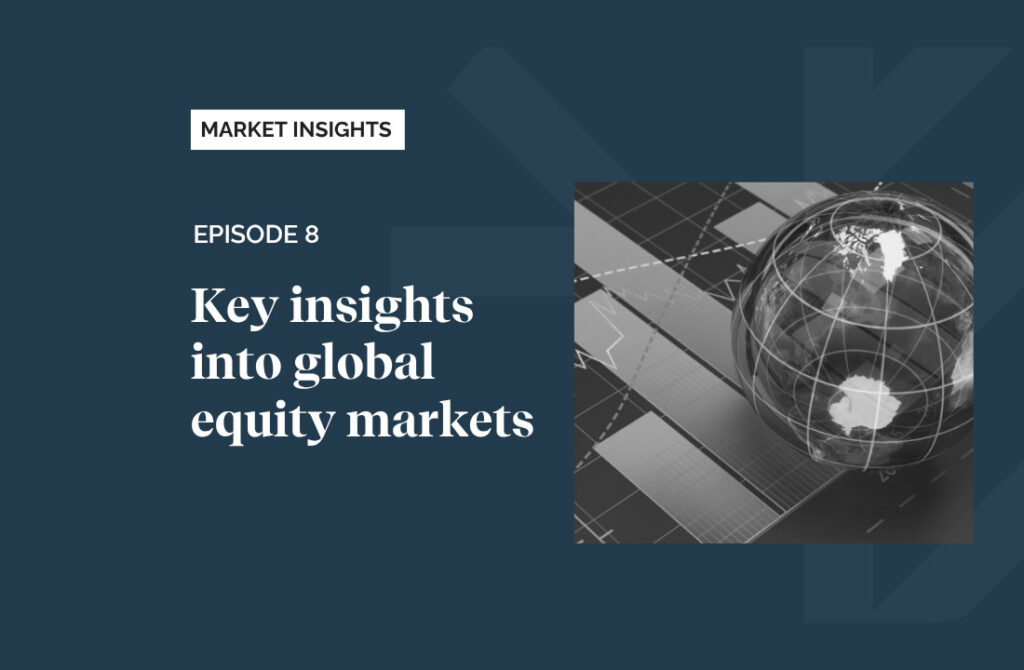Topics
Transcript
We’ve seen that the aggressive reciprocal tariffs that was announced, earlier in April has caused a lot of concerns about market participants around higher inflation in The US, as well as slower growth. We believe, therefore, that a stagflation risk still remains out there. A lot of damage has already been done, but we are starting to see that President Trump are trying to make some walkbacks on these tariffs. And most importantly, there’s some news out this week that this weekend, there will be a meeting between The US and China in Switzerland to discuss, the way forward. According to treasury secretary Scott Besant, he said that this meeting will be more around trying to deescalate rather than reaching a trade deal.
But we believe with him as well as James and Grier, which is the trade representative, and from China, Yi Le Feng in the room, we think that there could be enough scope to at least get to some sort of progress towards starting to talk about a trade deal. During Trump’s first hundred days, we’ve seen that the market is down roughly 10%. His approval rating has dropped from slightly above 50 to the mid forties. Markets are concerned about inflation and growth, and we still are sitting with a war that rage raging between Ukraine and Russia. So Trump is in need of some sort of a win.
And, therefore, if we look at the trade scenario at the moment, with a lot of uncertainties allowed there, we also need some wins and some news about potential trade deals coming to the front. So Scott Besant also this week said that there is at least a dozen countries out there that wants to sign trade deals with The US. About 90% of The US global trade deficit comes from about 10 countries. So if we can get a handful of deals signed by these countries, we think that could alleviate a lot of pressure from this market. So overall, we think trade de escalation or trade tension de escalation will continue, but potentially not to the level where it was before and that a lot of the damage and growth has already been done.
And we can see that by looking at the first quarter GDP numbers. We saw that there was a contraction in The US of 0.3% in the first quarter. And when we look at the different components, we can see that trade disruption has played a big role. So looking at the negative contributors, net exports was the biggest negative contributor. Why?
Because we saw a lot more imports coming into The US than has been exported and therefore a front running of imports is happening to ensure that these imports don’t get hit by the tariffs. That’s caused the big negative, in terms of GDP growth. We also saw that private residential investment was negative, which reflects a weak consumer backdrop. On the positive side we had inventory build up running quite strong. We had personal consumption also doing fairly well and we also saw that business investment has done a little bit better.
Now all three of these has also been driven and been influenced by front running. Inventory build up as wholesale retailers believe they need to bring in product before it gets hit by the tariffs. Business investment, also front running investment. And also on the consumption front, we saw that although personal consumption was positive, it has been the weakest in seven quarters, and a lot of the personal consumption has been supported by auto, auto sales, which is also due to front running. Overall, we think that there’s a lot of disruption in these numbers and that it still bodes, poorly for coming quarters as tight policy setting and uncertain policy and disruptive policy setting will continue to weigh on growth.
We also see that, the Fed chair Powell in the recent FOMC meeting said that policy is in a good place, that they can afford to wait and see how the economy will pan out before they react. So they’ve kept rates at four and a half percent, which means that the overall policy setting remains fairly tight. You also mentioned that there is a difference between the hard data and the soft data. And while the soft data, which is often the surveys, has weakened quite substantially, the hard data, which reflects the actual activity, has remained fairly robust. Now we believe it’s just a matter of time before the hard data will also roll over because typically soft data leads the hard data.
China has also been hit bad by this trade war. If we look at the high frequency trade data, we saw that while in April it holds up fairly well, towards the April you saw weakening in trade activity and also if you look at the surveys of economic activity for this month we saw also a slight weakening. So as promised the Chinese authorities came in and introduced some support measures. Just this week, they cut the policy rate by 10 basis points. They cut the reserve requirement ratio by half a percent, which means that will bring in another, trillion RMB in liquidity back into the economy.
They’ve also increased the relaying program to several sectors. They’ve increased that to by 1,100,000,000,000.0 RMB and also brought in measures to support capital markets as well as the property sector. So we continue to see that the Chinese is willing and able to support the economy against this trade war. And this ultimately is good for emerging markets. But there are other factors also that’s playing out at the moment that’s good for emerging markets.
And in particular, we saw that the oil price continues to fall. The oil price dropped from about $80 earlier this year to $60 more recently. So the reason behind this drop in the oil price is, one, because of a weaker global growth outlook. The IMF recently reset or downgraded the global growth outlook to 2.8%. That is from an average of around three and a half percent for the last five years.
And also OPEC plus has come in, and they said they will be reducing the production cuts. They anticipate a 400,000 barrels per day increase of production in May and another 400,000 in June. So bringing supply back into the market to potentially win market share again and driving down the oil price. With the low oil price, it’s also good for South Africa. And even before the full oil price drop has been factored in, the recent inflation print came out at 2.7%.
So head down inflation, the latest reading was 2.7% which is now below the 3% lower band of the target range. If you look at the different components within that drop, it has been broad based, which means that it’s a weak economic environment as well as an overall tight policy setting that is causing inflation to be running as low as it is, and therefore there is scope for the SARP to to cut interest rates. So as weak as growth, oil prices coming down, inflation is falling, inflation expectations is falling, the rand is holding up fairly well and we saw that the VAT hike was scrapped, which we think means that the scope for the SARB to cut interest rates at their meeting on the May 29. And we believe after this cut, they will continue to cut throughout the rest of the year. We could potentially get between two and four cuts over the next twelve months from the SARB.
So finally, while we believe the reduction in trade tensions is positive for global markets, we believe that we still want to be cautious on The US front and see more opportunities on the emerging market front, where lower inflation means that there’s more scope to ease policy, where the oil price is lower, helping consumption in in those emerging markets, and also where a weaker US dollar is benefiting emerging markets. Thank you for watching.
FAIRTREE INSIGHTS
You may also be interested in
Explore more commentaries from our thought leaders, offering in-depth analysis, market trends and expert analysis.

Macro Pulse Episode 21
In this episode Jacobus discusses SA equities, SA bonds and the appreciating of the US dollar.

Fairtree Market Insights with Karena Naidu | Episode 8
In this episode, we dive into our Chinese exposure, exploring what’s happening with the major e-commerce players in China. We also take a closer look at the broader emerging markets space, unpacking key trends and where we’re seeing potential growth.

Macro Pulse Episode 20
In this episode, Jacobus discusses major events leading up to year-end, recent US court cases, and the rise in long bond yields.
About you…
By proceeding, I confirm that:
- To the best of my knowledge, and after making all necessary inquiries, I am permitted under the laws of my country of residence to access this site and the information it contains; and
- I have read, understood, and agree to be bound by the Terms and Conditions of Use described below.
- Please beware of fraudulent Whatsapp groups pretending to be affiliated with Fairtree or Fairtree staff members.
If you do not meet these requirements, or are unsure whether you do, please click “Decline” and do not continue.




